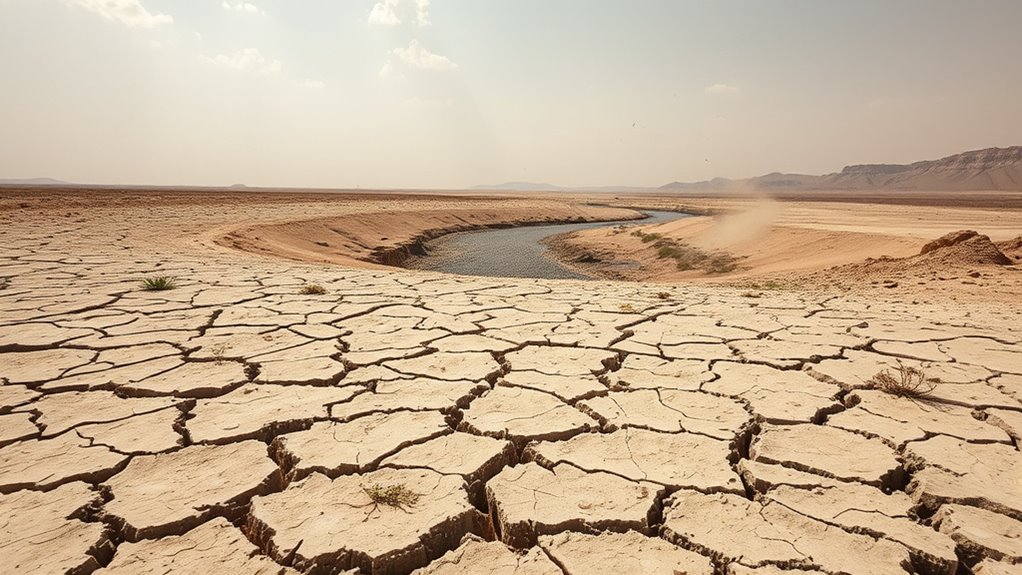Water scarcity is an urgent crisis you can’t ignore. Growing populations and climate change are reducing freshwater supplies, putting communities and ecosystems at risk. Advances like desalination offer solutions, but they also consume a lot of energy. Conservation efforts, such as fixing leaks and using water-efficient appliances, are essential to stretch limited resources. Staying informed and taking collective action can make a difference—if you think this affects you, there’s more to uncover beyond the surface.
Key Takeaways
- Water scarcity threatens global health, agriculture, and ecosystems due to increasing demand and climate change impacts.
- Technological solutions like desalination can expand freshwater supply but require significant energy and environmental considerations.
- Conservation strategies and public awareness are vital to reducing water consumption and alleviating pressure on limited resources.
- Investment in infrastructure, sustainable policies, and innovative technologies are essential for long-term water security.
- A combined approach of demand reduction and technological advancement is critical to addressing the looming water crisis.

Have you ever wondered what life would be like without enough clean water? It’s a sobering thought, especially as water scarcity becomes an increasingly urgent problem worldwide. As populations grow and climate patterns shift, the availability of fresh, drinkable water declines, leaving communities vulnerable and ecosystems strained. Fortunately, technological advancements like desalination are making a difference. Desalination advancements have transformed how we can turn seawater into a usable resource, providing a potential solution for regions facing severe water shortages. Modern desalination techniques, such as reverse osmosis, are more efficient and cost-effective than ever before, allowing coastal cities to tap into vast ocean reserves. Still, these processes require significant energy, which raises concerns about their environmental impact. That’s where water conservation strategies come into play. Implementing water conservation strategies isn’t just about saving a few gallons here and there; it’s about fundamentally changing how you use water daily. Simple actions—fixing leaks, taking shorter showers, using water-efficient appliances—can collectively make a substantial difference. When you actively conserve water, you lessen the pressure on already strained supplies, helping to stretch existing sources further. These strategies also serve as a reminder that water isn’t an infinite resource; it’s precious and limited. Additionally, Gold IRA investments can serve as a hedge against economic instability caused by resource shortages, including water crises. Combining conservation efforts with technological innovations like desalination creates a more sustainable approach to managing water scarcity. While desalination can provide a new supply of freshwater, it’s not a silver bullet. The high energy costs and environmental concerns mean it should be part of a broader strategy that includes reducing demand through conservation. You can play an essential role by adopting water-saving habits and encouraging others to do the same. Public awareness and responsible water management are fundamental to overcoming this looming crisis. Governments and communities need to invest in both infrastructure and education, emphasizing the importance of conserving water and supporting advancements in desalination technology. The future of water availability depends on how effectively we combine cutting-edge solutions with everyday conservation efforts. By understanding the importance of these strategies and technologies, you can contribute to a more sustainable water future. The challenge is huge, but with collective action, innovation, and commitment, we can mitigate the worst impacts of water scarcity. It’s a shared responsibility—your choices today can help help guarantee clean water remains accessible for generations to come.
Frequently Asked Questions
Which Countries Are Most Affected by Water Scarcity?
You should know that countries most affected by water scarcity often face desertification hotspots, impacting their water availability. Nations like India, Pakistan, and parts of Africa struggle with limited water access due to poor water management policies. These issues worsen with climate change, making it essential for you to support sustainable solutions. Addressing desertification hotspots and improving water management policies can help these countries secure their water future.
How Does Climate Change Influence Water Availability?
Climate change causes chaos in your water cycle, creating climate feedback loops that impact water availability. As temperatures rise, evaporation accelerates, drying out sources and reducing rainfall. This disruption diminishes water supply, forcing communities to face fresh shortages. You see, climate change’s cascading effects intensify droughts and deplete water reserves, making it harder for everyone to access clean water. It’s a cycle of scarcity spiraling with every warming event.
What Are Innovative Solutions to Water Scarcity?
You can tackle water scarcity by embracing innovative solutions like water recycling and desalination technology. Water recycling allows you to reuse wastewater for irrigation or industrial use, reducing demand on freshwater sources. Desalination technology converts seawater into drinkable water, expanding available supplies. These methods help address shortages, protect ecosystems, and ensure a sustainable water future for communities facing increasing pressure from climate change and population growth.
How Can Individuals Reduce Their Water Footprint?
Imagine a gentle stream flowing through your daily routine. You can reduce your water footprint by practicing water conservation in your personal habits—like fixing leaks, taking shorter showers, and turning off taps while brushing. Small actions add up, saving gallons of water and easing pressure on local water sources. By being mindful, you become part of the solution, helping to preserve this essential resource for future generations.
What Role Does Agriculture Play in Water Depletion?
Agriculture considerably impacts water depletion through inefficient irrigation practices and a large crop water footprint. When you support sustainable farming, you help reduce water waste. Choosing products from farms that use drip or precision irrigation can make a difference. By understanding the crop water footprint, you become more aware of how much water your food requires. Your choices can promote water conservation and encourage better agricultural practices.
Conclusion
If you ignore the rising tide of water scarcity, you’ll find yourself stranded on a dry, cracked earth, desperately searching for a drop of hope. Like a fragile glass teetering on the edge, our precious water supply teeters on the brink of collapse. But you hold the power to turn the tide—by conserving, innovating, and advocating. Don’t let this crisis drown your future; act now before the floodgates of scarcity slam shut forever.










